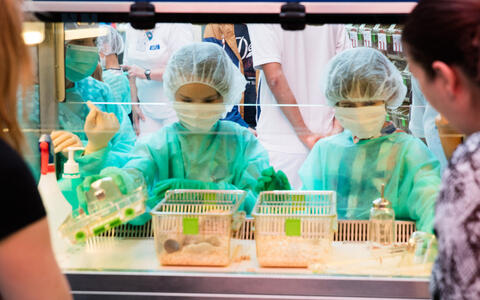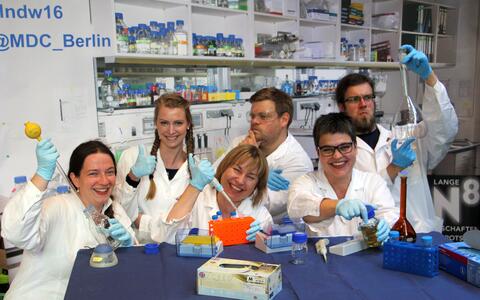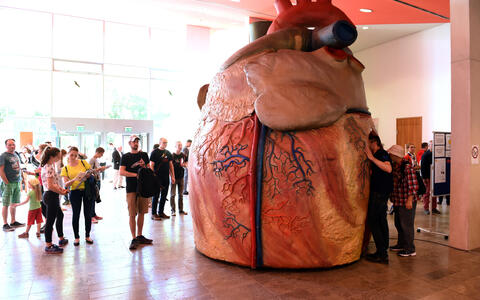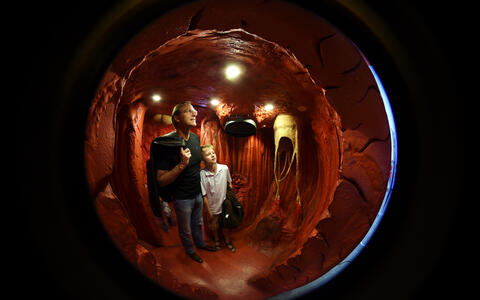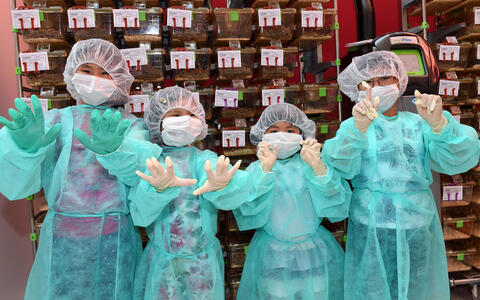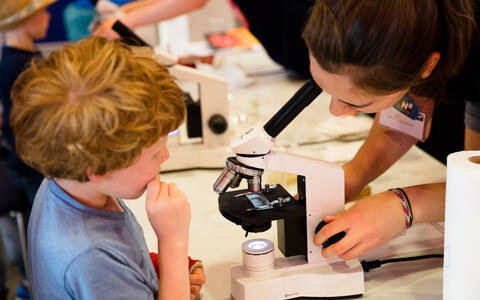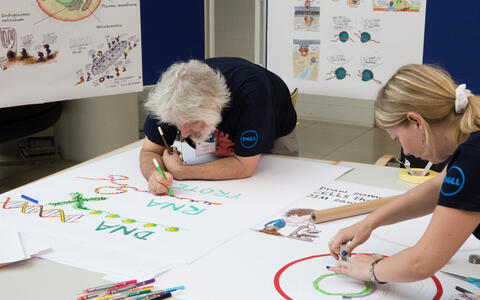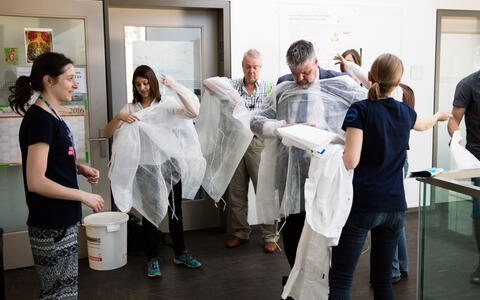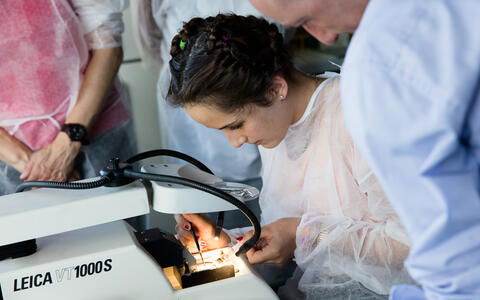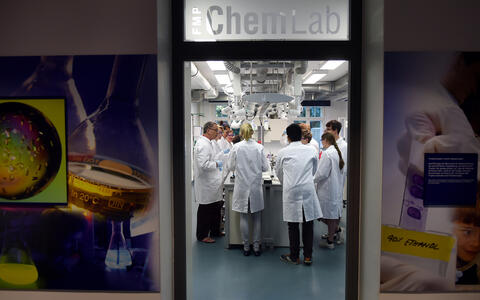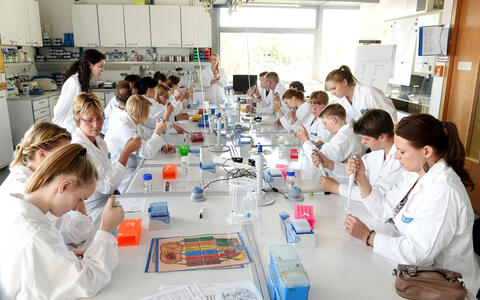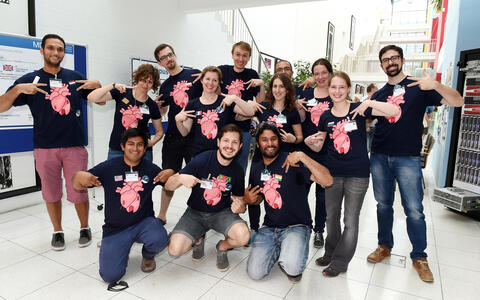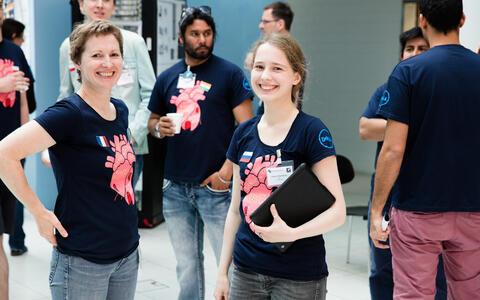Sugar and spice and all things mice
The Hermann von Helmholtz building – located right next to the MDC Conference Center (MDC.C) – is a hive of activity. Several trainee animal carers – easily recognizable from their green lab coats, hair nets and gloves – are busy carrying mice to and fro. Overseeing this task is the head of the Animal Facilities department at the MDC, Karin Jacobi. “Once a week, the test mice kept in our animal housing facilities have to be moved so that we can clean the cages,” she explains to her attentive group of students. But these are not actual trainees; they are girls and boys who are visiting the MDC to learn more about the research carried out here – for example about how mice at the MDC’s animal house are kept and cared for, and how they are used as test subjects for biomedical research.
Hands-on action at research stations
First of all, the cages must be carefully removed one by one from the ventilated shelving unit and carried to the transfer workbench located a few meters away. The young trainees begin by transferring the water bottle from the old to the new cage, followed by the food, the little house, the toys, and finally the mice themselves. These are not, of course, real animals – they are made from white and pink candy! Nevertheless, Jacobi still warns the children to be careful: “Don’t drop them or the mice will get confused. And that would be very bad as it might distort the results of our research!”
The “Mouse House” activity station is one of various research stations set up at the MDC’s main building to provide a hands-on experience of science. The stations are particularly geared toward younger Long Night of the Sciences visitors, as they are all about interaction and participation. At the station manned by science writer and cartoonist Russ Hodge, they have the opportunity to paint extra-large, colorful cells, while in the “molecule kitchen” two researchers freeze bite-size portions of soft meringue in liquid nitrogen, which they then invite the guests to come and try. Those brave enough to try them get to feel like a dragon for a few moments as clouds of “smoke” billow from their mouths and nostrils.
Scientists take you on lab tours
Throughout the evening, guests have the opportunity to go on a number of guided laboratory tours to discover more about the concrete research carried out at the MDC. This year, Gary Lewin and Marina Chekulaeva’s working groups are among those offering tours for the first time. Lewin’s group focuses on the topic of sensory perception, with guests on the “Touch and pain” tour learning all about how sensory stimuli are processed by the body. Lewin begins by presenting a microscopic image of the skin of a mouse’s rear paw to show where the touch receptors are located: directly at the roots of the hairs. “Our sense of touch is coded by genes,” explains Lewin. “We want to find out through our research which genes exactly are responsible for this and why the perception of pain and touch differs so greatly from person to person.”
MDC researcher Christiane Wetzel and her colleague Mirko Moroni stimulate neurons in a cell culture with capsaicin to render visible the electrical impulses that transmit the stimulus. Capsaicin is the chemical in chili peppers that makes them spicy, but it also transmits a feeling of warmth – “because the alkaloid binds to heat-sensitive receptors,” explains Wetzel. The tour then moves on to testing devices that are also used to examine “real” test subjects. One device measures how fast a person senses an increase or decrease in the temperature of an object placed against his or her skin. All participants on the tour exhibit the same results: it takes an increase of one degree for warming to be detected, while cooling is already felt with a decrease of half a degree. “That’s because sensitivity to cold is more important for our existence, as we start getting too cold more quickly than we get too hot,” explains PhD student Johannes Kühnemund. “Correspondingly, the body transmits this signal faster.”
There are also English-language lab tours
The English-language tour conducted around the laboratory of Marina Chekulaeva’s working group focuses on “New players in the genome.” Scientist David van der Bruck begins by introducing the object of investigation – RNA – as well as the methods and equipment used in the laboratory. To the disappointment of some of the guests, the sequencing machines are too sensitive and expensive to be on display. Instead, they can take a look at real, living stem cells under a microscope. Student Marta Mauri explains that other cell types can be grown from these stem cells via the process of differentiation, but that this process takes several weeks. The topic of stem cells naturally gives rise to many questions. One guest wants to know if the technique could be used to grow healthy cells that could be implanted into a sick person; another asks if sequencing allows scientists to find our which genes are responsible for determining hair color, and whether it could then be modified. Marta Mauri and her colleague Katja Glinsek answer that, unfortunately, this is not the case: their work is just the first of many steps that need to be taken before the scientific findings can be applied to everyday medical practice.
Chekulaeva’s team has prepared a fun little participatory experiment. The visitors get to try out the laboratory’s very fine pipettes and learn just how difficult it is to fill the narrow chambers of an SDS-PAGE gel with liquid samples. This technique is used, for example, to separate proteins in samples according to their size, thus allowing for certain proteins to be examined more closely.
The visitors are not permitted to take any cameras into these working laboratories, but authentic-looking lab photos can be taken at the “selfie station” set up in the foyer of the MDC.C. Here, the MDC communications department has erected a life-size laboratory backdrop along with a table featuring all the necessary equipment such as lab coats, reaction vessels, pipettes, gloves and safety goggles. This backdrop allows various lab-based scenarios to be staged and photographed, and proves particularly popular with families and couples. The overall consensus: getting a hands-on experience of science is great – especially when you get to take away a special photo as a memento of your experience!


